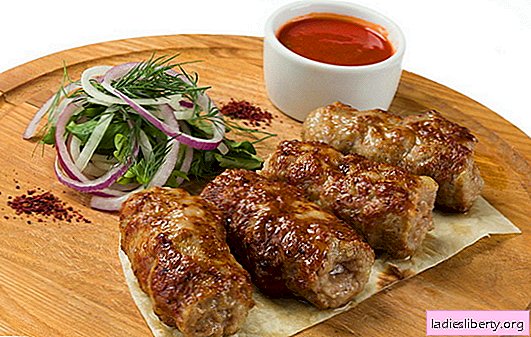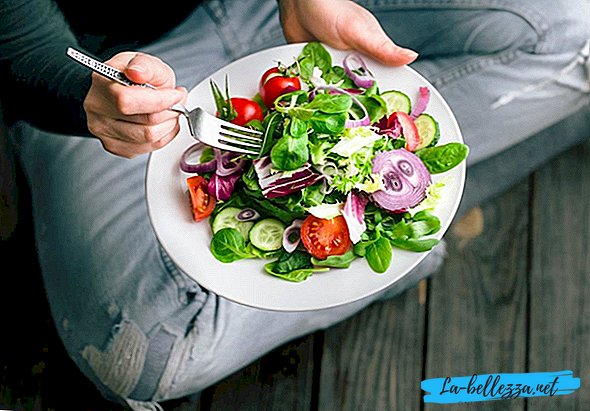
We are what we eat. More precisely, it is also “how”, “when”, “why” and “how much”. Often a person eats not because he is hungry, but because he is sad, lonely, bored, or he is under stress. To call such a balanced nutrition is difficult. Today, many methods of proper eating have been developed. The rules of most of them are universal.
Principles of balanced nutrition

The basic principles according to which the correct healthy diet is made up include several methods that are the basis of any diet. Such principles are relevant for any balanced menu. So, to optimize your diet, you must comply with the following conditions:
- Adhere to a balanced diet should be for as long as possible, ideally - a lifetime. Otherwise, you just do the fasting days / weeks;
- The menu should be varied and include the necessary products for the normal functioning of the body for the day and the week;
- The caloric intake of the meals consumed per day should fill the energy costs, but not exceed the recommended daily rate for each age and sex category;
- The balance in this case is meant by the ratio "the needs of the body - the useful components contained in the products."
Also, the methods of healthy eating include numerous dietary recommendations, namely:
- Observe the fragmentation of food and include in the daily diet 3 large and 2 small meals. Breakfast is extremely important for energy recharging, but a very small number of people can eat a hearty meal or a few in the morning. It is not necessary to overeat and lunch: better arrange yourself snacks between, but do not fill your stomach for the rest of the day;
- If you feel that you need to throw off those extra pounds, you should not sharply cut down the daily ration, volume and quantity of foods eaten. Reduce portions gradually, with an emphasis on the caloric content of meals cooked and absorbed per day;
- It is important not to eat enough and not to starve - it is better to eat so that you do not have time to get hungry during the day. So the metabolism works more efficiently and burns calories more actively. Do not forget that, skipping breakfast, you will not lose weight, but only worsen your health;
- The ideal breakfast consists of "slow" carbohydrates - cereal porridge, foods high in fiber. They are digested longer and give a full sense of satiety for a few hours. In addition, such foods, eaten during breakfast, help to keep insulin in the blood at an optimal level throughout the day;
- The best seasoning for meat is not pepper or ketchup, but a side dish of vegetables (raw, stewed or boiled). There are meat dishes and products with the addition of foods high in carbohydrates (potatoes, etc.) is not particularly useful. Consuming meat for breakfast is also not recommended, it is better to do it at lunch;
- Per day you need to consume 3 - 5 fruits, but do it in the morning. If there are fruits that contain natural acids and sugars, not for breakfast or during the day, but in the evening, this will not work for you. You will feel an increase in appetite, and consumed sugar will provoke a jump in insulin in the blood;
- Try to drink enough pure water without gas. It should be at room temperature. It is better to drink it for a certain amount before or after a meal. In the morning on an empty stomach, before breakfast, drink a glass of clean, warm water without gas to activate digestion.
To eat right, it is important to understand that not only the amount of food eaten per day, but also its composition affects the energy replenishment. Calculate caloric intake in several ways.
How to calculate energy consumption?

There is a way to calculate energy consumption, which is definitely useful to those who are going to eat according to the principles of a healthy balanced diet. On its basis, the required amount of food for consumption per day is determined, which allows to completely cover the body's needs for the energy spent for processing the incoming proteins, fats and carbohydrates.
Important: 25%: 15%: 60% - the formula for calculating energy consumption for an adult, physically active person. This takes into account that men consume more calories than women.
The ratio of components should be 25, 15 and 60 percent. respectively. This nutritional formula works under the condition that the person sticking to it keeps physical activity every day and consumes healthy, balanced food.
How to balance the diet?

Professional nutritionists have several formulas that help to remove the composition for a perfectly balanced diet. The basis of the majority of calculations is the number of energetic substances that come in every day with food, including lipids, fats, and proteins (protein). The ratio of the first two components is taken as the basic unit, while the amount of carbohydrates consumed per day should be four times more.
Nutritionists call this formula "triple plate principle"where the conditional dish of food eaten per day is divided into 3 sectors. The share of carbohydrates accounts for two sectors, while lipids and proteins occupy only 1 sector.
At the same time, another is proposed. average formulaincluding the following parameters:
- The proportion of carbohydrates in the daily diet - 35%;
- The share of proteins and fats is 30% for each component, respectively.
To achieve the optimal ratio of calories consumed as "energy fuel", using these principles to create a balanced diet, is quite simple. For those who want to eat according to dietary canons, it is useful to get a diary and add to it every day the amount of protein, carbohydrates and fats consumed.

To calculate the ratio of healthy nutrition in one day, you can use virtual applications (there are a huge number of free programs). If during the registration process it turns out that you consume more or less calories per day than necessary, reconsider the composition of your menu.
Products that should be completely excluded from the diet:
- Chips, nuts, salty products (snacks);
- Fast food (in any form);
- Sweet carbonated drinks;
- Alcohol;
- Fatty and fried foods;
- Mayonnaise;
- White sugar;
- Smoked products, marinades, sausages and smoked products;
- Ice cream (this product is triple harmful as it is fatty and sweet at the same time, and also consumed cold).
A balanced healthy menu for the day includes foods such as:
- Red fish meat (source of unsaturated fatty acids);
- Green vegetables and plants: cabbage (all kinds), broccoli, spinach, zucchini, zucchini, asparagus, etc .;
- Legumes: beans, lentils, peas, nuts, etc .;
- Dairy products;
- Cereal products;
- Potatoes;
- Lean varieties of meat, fish, poultry.
Rules of eating

The principles of a healthy balanced diet imply a special method of eating. It contains the most optimal ratio of energetic substances and the number of calories so that the metabolic processes in the body proceed without failures.
Nutritionists secreteten basic rules for eating:
- Try to always have a calm atmosphere. In the process, concentrate on food, not on the smartphone or audio streams coming from the TV, laptop, etc. Literally, you should constantly look at the plate and fully concentrate on how you are chewing at the moment. Talking with meals is also not welcome. Such a rigorous approach looks comical, but just so digestive processes are activated to the maximum and the absorption of useful substances takes place optimally;
- Plan your day so that breakfast, lunch and dinner take place at about the same time. Thus, you will accustom the body to the correct diet;
- It should be in a sitting position so that the area of the epigastrium is not crushed. Eating when standing, on the move or lying down is a direct path to gastritis;
- When the food is absorbed in the nervous state, the digestive system spasms, due to which the process of processing the food that has entered the stomach and intestine is slowed down and significantly worsens. Do not eat in a state of nervous excitement.I, give up the habit of "seize" stress. This condition does not contribute to the sufficient production of digestive enzymes;
- You can not overeat. In the eye, we are able to eat about 70% of what is on the table, whereas to saturate 25 to 30% of cooked food is really needed (Of course, everything is individual and depends on the portions). However, the essence is unchanged: the absorption of an excess amount of food leads to stretching of the stomach walls, deterioration of digestion, stagnation of food coma and putrefactive gases in the process of its fermentation in the intestine;
- Cold food - "hit" on the pancreas. In addition, for its warming the body spends additional energy, which is bad for the metabolism. If possible, eat warmed. Too hot food also adversely affects the condition of the gastric mucosa;
- Putting dishes on a plate, try to arrange portions in moderate volume. The larger the plate, the larger the portion we usually put, and this does not contribute to a balanced diet. Visual deception with the use of smaller diameter dishes is a fun, but rather effective solution;
- Chew food thoroughly and do not swallow large pieces. In this case, breakfast and lunch should be the most high-calorie of all meals, and dinner - the easiest. Meals prepared for evening meals are better absorbed if they are cut into small pieces or cooked in liquid / semi-liquid / puree form;
- When signs of hunger appear (rumbling in the stomach, feeling of “sucking” under the spoon) try to eat immediately. Do not torture yourself and do not wait for certain hours, even if your schedule is painted this way. That is why it is important not to miss the two snacks allowed during the day;
- After eating, it is not recommended to take a lying position, no matter how much you want it. Stay upright for at least a quarter of an hour.
Approximate weekly diet

Eating right doesn’t mean living on the same porridge or broccoli puree. A healthy diet must include a variety of foods and dishes, otherwise the body will not receive a full-fledged complex of vitamins and minerals. At the same time it is necessary to observe the mode of the correct use of food and not to overdo it with its quantity.
Home-cooked food is, of course, healthier than convenience foods, and few people can eat at least three times in cafes or restaurants every day. Therefore, you should learn how to cook simple healthy meals and organize a diet in such a way as to comply with full 3 meals and 2 snacks.
The main goal of a balanced diet is the timely saturation of the body with nourishing healthy foods and the avoidance of hunger.
To do this, make a sample menu for seven days (5 meals per day), paint each meal, and stick to it during the work week and on weekends.
Monday:
- Breakfast: protein omelet with fresh dill, rosehip tea;
- The first snack: homemade milkshake with strawberries;
- Lunch: broth with boiled vegetables, beef steamed meatballs with buckwheat, dried fruit compote;
- Second snack: a handful of nuts;
- Dinner: broccoli casserole with cheese, a glass of kefir.
Tuesday:
- Breakfast: cheesecakes with honey, black weak tea;
- The first snack: natural yogurt;
- Lunch: vegetable stew, potato zrazy, tea from linden inflorescences;
- The second snack: toast with butter, jelly;
- Dinner: braised cod with boiled potatoes, compote with prunes.
Wednesday:
- Breakfast: pancakes with cottage cheese, cocoa;
- The first snack: banana and yogurt;
- Lunch: green cabbage soup, boiled chicken (150 g), cauliflower in breadcrumbs, mineral water without gas;
- The second snack: toast with jam, milk with cinnamon;
- Dinner: beef chops with pea puree, tea with dryers.
Thursday:
- Breakfast: cottage cheese casserole with sour cream, coffee with milk;
- First snack: fruit salad;
- Lunch: millet porridge with turkey meatballs, grated cabbage salad with carrots, cranberry juice;
- The second snack: nuts with raisins, herbal tea;
- Dinner: draniki with tomato sauce, a glass of ryazhenka.
Friday:
- Breakfast: cottage cheese with prunes, tea;
- The first snack: boiled egg, cocoa;
- Lunch: stewed chicken with asparagus, tomato soup, peach compote;
- The second snack: a handful of prunes, kefir;
- Dinner: beef stewed with rice, milk kissel.
Saturday:
- Breakfast: lazy dumplings with jam, elder tea;
- First snack: a sandwich with cheese and tomatoes on a gray bread;
- Lunch: stewed zucchini, a piece of boiled beef, fruit jelly;
- The second snack: a handful of dried apricots, a glass of freshly squeezed carrot juice;
- Dinner: baked chicken fillet with brown rice, vegetable salad.
Sunday:
- Breakfast: boiled pearl barley, grated carrots with butter, green tea;
- The first snack: baked apple;
- Dinner: mashed corn flour, stewed and fried fish fillet, vegetable salad, a glass of mineral water;
- The second snack: a glass of kefir with a biscuit;
- Dinner: potato casserole, tea with mint.
Composing the menu for the week, remember that repeating dishes is possible and necessary, otherwise you will simply get tired of the need to prepare a variety of recipes every day. The main thing is to keep the food healthy and be processed by permitted thermal methods (cooking, stewing, baking).











